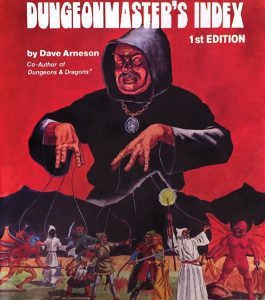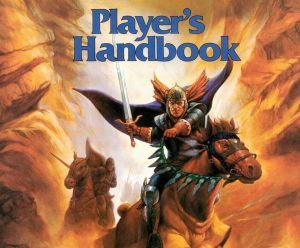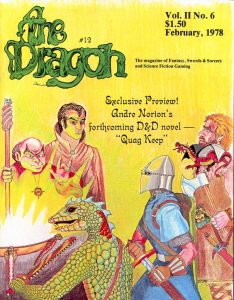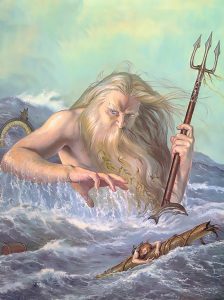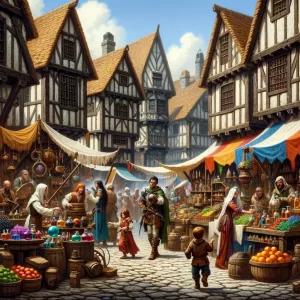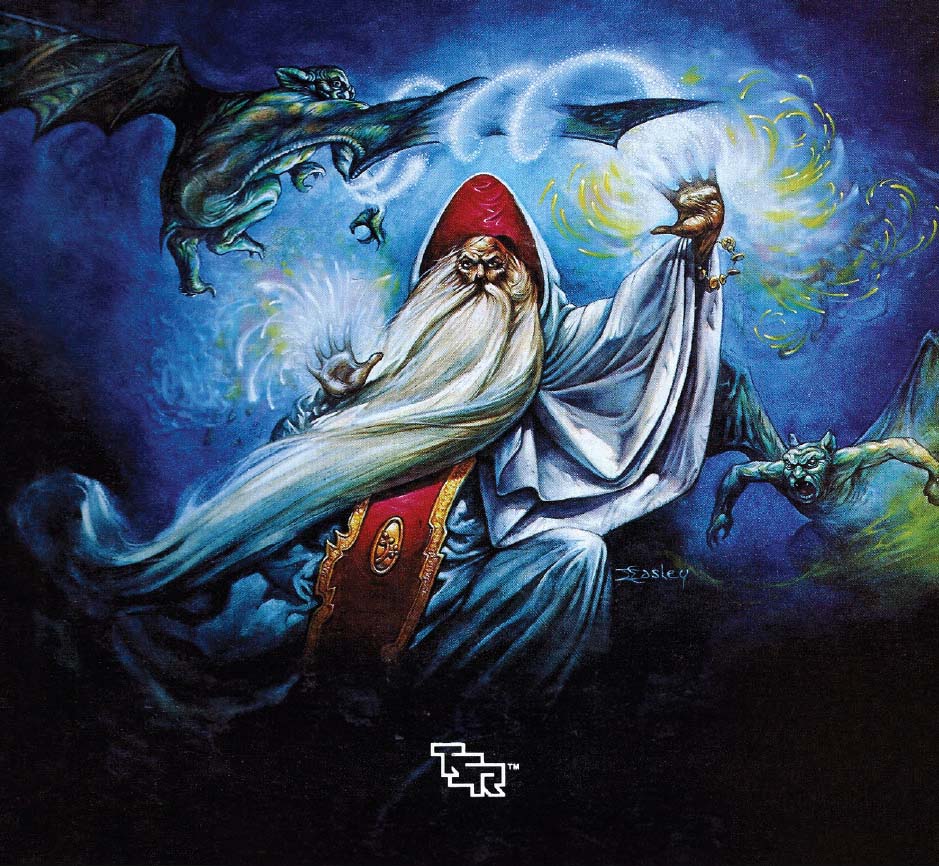
Learn about AD&D 1st Edition Monster Stat Blocks
What You Need to Know Right Now
AD&D is about exploring dangerous places, fighting monsters, and finding treasure. Your character will probably die. That's normal. Roll up a new one and keep going.
Welcome to Advanced Dungeons & Dragons 1st Edition! This crash course guide is for brand-new players and Dungeon Masters. If the rulebooks feel confusing, don't worry. This crash course teaches you the core basics so you can start playing right away.
Step 1: Make a Character
Roll Your Ability Scores
Roll three six-sided dice (3d6) for each of these abilities: Strength, Intelligence, Wisdom, Dexterity, Constitution, and Charisma. Write the numbers down in that order. Normally, you can't move them around. Bad rolls? That's part of the game. But the official rulebooks do offer other methods if your DM allows it, like rolling more dice and choosing the best ones, or assigning scores where you want. This crash course sticks with the classic method.
Ability Scores
Strength (STR) is your muscle. It boosts your chances to hit in melee, adds extra damage when you connect, and lets you lug around more gear without breaking a sweat. Barbarians love it. Wizards pretend it doesn't exist.
Intelligence (INT) is the domain of magic-users. It determines how many languages your character can speak, how complex their spells can get, and whether they can even understand the dusty old scroll they just found. Low INT? Hope you like grunts and single-syllable words.
Wisdom (WIS) helps clerics bring the divine smackdown. It gives bonus spells and helps you resist magical mind games like charm and confusion. It's also the stat most players forget to respect until they're mind-controlled into punching their party.
Dexterity (DEX) is for the nimble. It makes you harder to hit (lower AC), helps with ranged attacks, and is a thief's best friend. High DEX means you duck, dodge, and deal damage before the ogre finishes tying his shoes.
Constitution (CON) keeps you breathing. More hit points, better saves vs. poison, and a longer life expectancy. It's the stat that decides whether you're mostly dead or all dead.
Charisma (CHA) is your social spark. It determines how many loyal henchmen you can keep, how NPCs react to your face, and whether those followers actually stick around after the third near-death dungeon dive. High CHA? You're a leader. Low CHA? You're lucky they don't sell your gear and leave you for dead.
Together, these six stats form the bones of your character. How you use them determines whether you're the hero of legends - or just another skeleton in the dungeon.
Deep Dive Ability Scores
In Advanced Dungeons & Dragons, ability scores are core attributes that define a character's potential, limitations, and survival chances in the fantasy world. Each ability score ranges from 3 (abysmal) to 18 (legendary), and each one affects different mechanics, roles, and outcomes during gameplay. Here we explore them with mechanical clarity.
Strength (STR) measures physical might, carrying capacity, and melee power. It influences:
Hit probability in hand-to-hand combat
Damage dealt in melee
Weight allowance (in gold piece equivalents)
Door-opening rolls (chance out of 6 to force open stuck doors)
Bend Bars/Lift Gates (a rare feat, expressed as a percentage chance)
Only Fighters with an 18 Strength may roll for "exceptional strength" (18/01-00), gaining even higher bonuses to hit and damage.
Intelligence (INT) governs memory, reasoning, and the ability to learn and use magic (especially for Magic-Users). Effects include:
Number of additional languages a character can learn
Spell level limits and the chance to learn individual spells (for Magic-Users)
Minimum/maximum number of spells per spell level
Literacy and general problem-solving potential
Wisdom (WIS) reflects common sense, willpower, and divine attunement. Clerics rely on it heavily. Effects include:
Bonus spells for Clerics (WIS 13+)
Saving throw adjustment against mental effects (e.g. charm, fear)
Spell failure chances for Clerics with low Wisdom
Dexterity (DEX) measures agility, reflexes, and coordination. It directly impacts:
Armor Class (AC) modifiers (bonus or penalty)
Initiative and missile attack accuracy
Saving throws against effects requiring quick reactions (e.g. breath weapons)
Success rates for thief skills (pick pockets, open locks, hide in shadows, etc.)
Constitution (CON) is a measure of endurance, health, and resistance to trauma. It influences:
Bonus (or penalty) hit points per level (Fighters may get more than +2 per die)
Survival chances from system shock (e.g. polymorph, magical aging)
Resurrection survival chance (e.g. Raise Dead or Resurrection spells)
The number of times a character can be revived (each resurrection reduces CON by 1)
Charisma (CHA) is the measure of charm, influence, and leadership. It governs:
Maximum number of loyal henchmen
Loyalty base (modifies morale and dependability of NPC followers)
Reaction adjustment (affects initial disposition of creatures or NPCs)
High Charisma makes recruiting easier and social encounters smoother; low scores can end conversations fast.
Racial Ability Modifiers:
Dwarves: +1 CON, -1 CHA
Elves: +1 DEX, -1 CON
Halflings: +1 DEX, -1 STR
Half-Orcs: +1 STR, +1 CON, -2 CHA
Humans: No adjustments
Non-human characters often have racial minimums and maximums for certain ability scores, which are applied after rolling and applying bonuses/penalties.
These stats aren't just numbers - they define your role, your edge, and your odds of making it back from that dungeon crawl in one piece.
Choose a Race
You can be a Human, Elf, Dwarf, Halfling, and more. Each race gives you bonuses like better vision in the dark and limits, like how high you can level up.
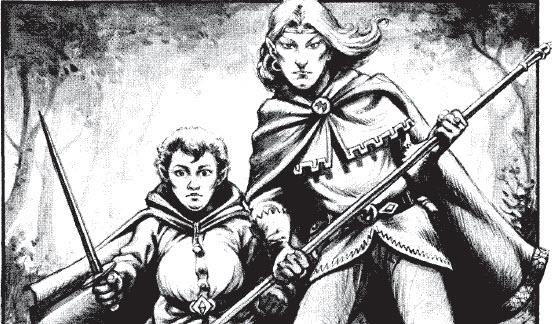
About the Races
Gnomes
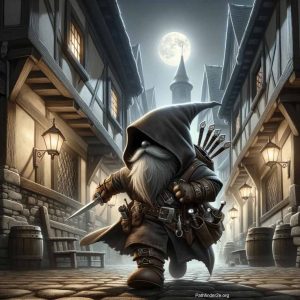
Small and clever, gnomes like quiet hills, good jokes, and dangerous tunnels. They're best suited for illusion magic, sneaky backstabbing, or poking things with tiny swords. While they can't become clerics or mighty wizards, their favorite trick is detecting dangerous stonework like slopes or shaky ceilings. They can see in the dark, talk to burrowing animals (because why not?), and they're unusually tough to hit with magic. Gnomes get bonuses when fighting goblins and kobolds, and giants somehow can't seem to land a blow.
Dwarves
Dwarves are grumpy, proud, and tougher than dungeon brickwork. They live in the mountains, hate goblins, and trust gold more than strangers. They make great fighters and decent thieves, but magic? Not a chance. Dwarves are short, strong, and suspicious, with a knack for sniffing out traps and bad stonework. They get big bonuses resisting magic and poison, and enemies like ogres and giants have a hard time hitting them. Just don't expect them to charm anyone - their charisma is better left at the bottom of a mug.
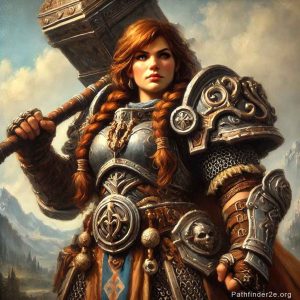
Dwarves, aren't trained trap specialists like thieves, but their deep knowledge of stone and mining gives them a natural edge. If they're actively checking the area, they have a 50% chance to notice traps involving pits, shifting walls, or falling blocks built into stonework. This isn't automatic - the dwarf has to actually be looking.
Elves
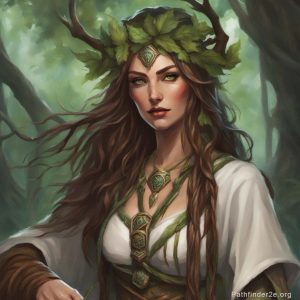
Elves are graceful, aloof, and probably judging your fashion sense. They're born to wield magic and bows, and while they bruise easier than dwarves, they make up for it with keen senses and sharp swords. Elves are sneaky, silent, and somehow always know when there's a secret door nearby. They get bonuses when using long or short swords and bows (no crossbows, please - too uncivilized). Their resistance to charm and sleep spells is legendary, and when traveling alone, they often get the drop on monsters. Don't ask them to dig a tunnel though - that's for the short folk.
Halflings
Think of halflings as cheerful burglars with good aim. They're small, nimble, and really hard to hit with magic or poison. Halflings aren't built for flashy magic or heavy fighting, but they're born to sneak, hide, and throw things at your ankles. They love food, comfort, and messing with monsters. They get bonuses when surprising enemies, especially when alone or far ahead of their party. Some even see in the dark, depending on their bloodline. And while they might not look tough, try hitting one - you'll miss.
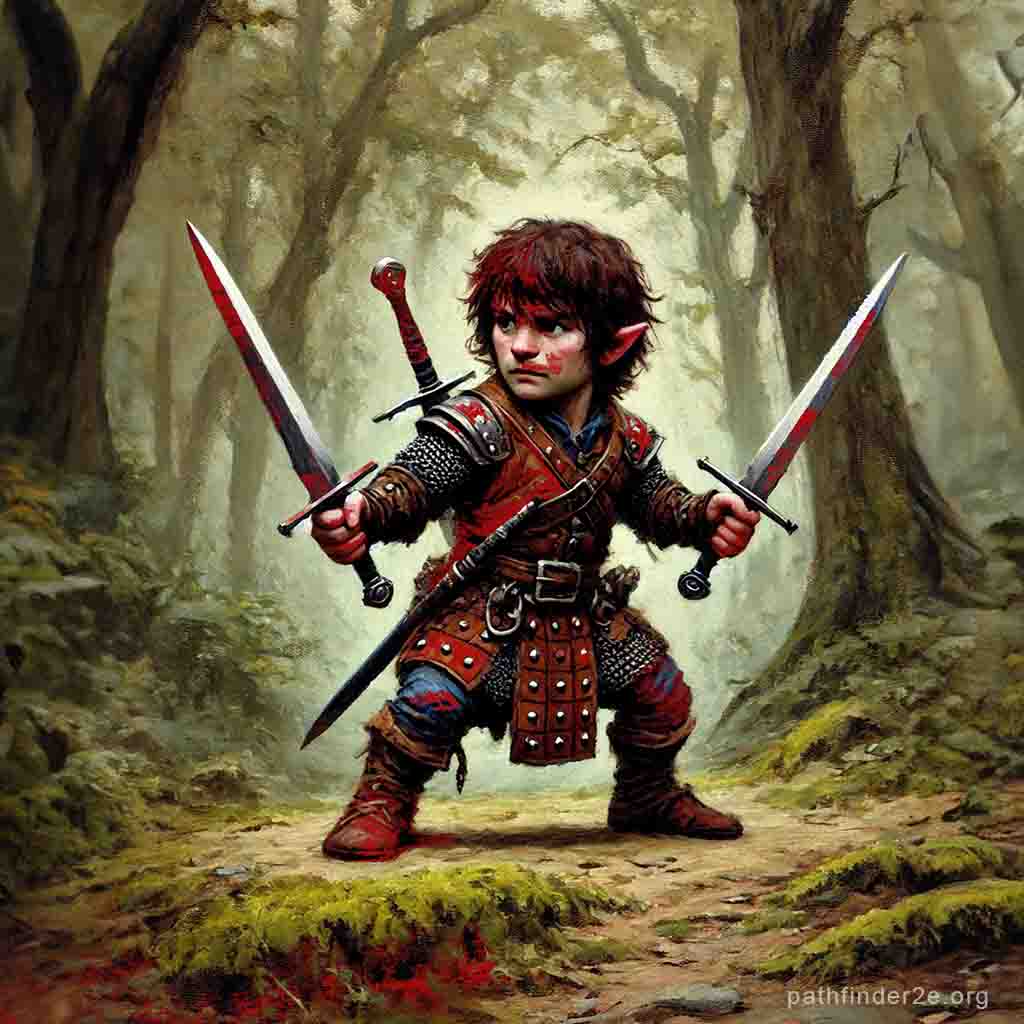
Half-Elves
Half-elves are the kids stuck between two worlds - not quite elf, not quite human, and just flexible enough to get into all kinds of trouble. They don't get any big stat bonuses, but they make up for it by being able to do almost everything. With decent magic resistance, good night vision, and lots of class options, they're a jack-of-all-trades. Half-elves can multi-class more ways than you can count, and they're one of the few who can become bards. Nobody loves them, but nobody hates them either - which is kind of their thing.
Half-Orcs
Half-orcs are the kind of characters you want on your side in a bar fight - tough, mean, and not big on small talk. They're great at fighting and sneaking, but not so great at making friends. They get bonuses to Strength and Constitution, but their charm is somewhere around 'bad smell in an alley'. They can see in the dark, growl in Orcish, and usually don't get invited to elf parties. Still, if you want someone who can break down a door and stab the guy behind it, half-orcs are your go-to.
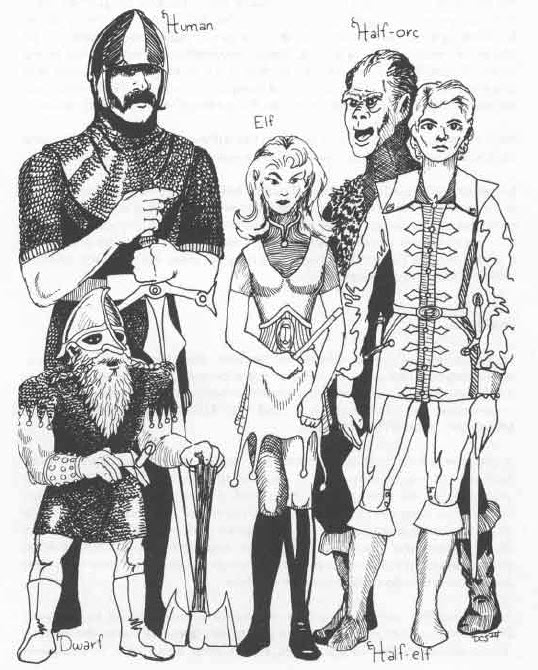
Humans
Humans are the boring middle of the fantasy sandwich - no darkvision, no special senses, no bonus against trolls. But what they lack in sparkle, they make up for in versatility. Humans can be anything, do anything, and go as high in level as they want. They're the only race that can switch careers midlife (called dual-classing), and they're one of the only ones that can become bards. In short: no perks, no limits. And in D&D, that's kind of a big deal.
What Is a Character Class?
In AD&D, your character's class is their job or profession. It's what they do best, like being a fighter, a magic-user, a cleric, or a thief.
Think of it like this: your class tells you what you're good at and how you play the game. If you're a fighter, you're strong in battle and use weapons and armor. If you're a magic-user, you study spells and cast magic to solve problems or fight enemies. If you're a cleric, you use magic from your god to heal and protect. If you're a thief, you sneak, pick locks, and find traps.
Your class affects how you fight, how you explore, and how you help your group. It also tells you what kinds of tools, weapons, or spells you can use, and how your character grows stronger over time.
So, choosing a class is like picking how you want to play the game. It's your character's role in the adventure!
Choose a Class - The Basics with Limits and Bonuses
Fighters wear lots of armor, use all weapons, and are best at surviving and fighting. They roll 1d10 for hit points. Fighters have no spellcasting but can deal with almost any enemy head-on. Most races can become fighters, and high Strength gives them big bonuses.
Clerics are holy warriors who fight undead and heal allies. They can't use swords but can wear heavy armor. They start with no spells at level 1. Roll 1d8 for hit points. Clerics get bonus spells for high Wisdom, and turn undead based on level. Some races like dwarves and half-elves make great clerics.
Magic-Users cast powerful spells eventually but are very weak at low levels. They start with 1 spell per day. Roll 1d4 for hit points. They can't wear armor and use only a few simple weapons like daggers and staves. High Intelligence helps them learn more spells. Only a few races can become magic-users.
Thieves are good at sneaking, picking locks, and finding traps. They use light armor and simple weapons. They use percent dice for skills like Open Locks. Roll 1d6 for hit points. High Dexterity boosts their success with skills. Thieves can be any race, and they improve faster than other classes at gaining levels.
More about Thieves
Thieves are great at spotting and disarming small mechanical traps, like hidden needles or spring-loaded blades. This is one of their core class skills, and it improves as they level up. For example, a 4th-level thief has a 35% chance to find or remove such traps, and that chance keeps climbing as they gain experience. They find traps by carefully inspecting things, not just by walking past and hoping for the best.
Multi-Classing and Dual-Classing
In AD&D 1st Edition, some characters can have more than one class. This means they can learn skills from different roles, like being a fighter and a magic-user at the same time. But how this works depends on whether your character is human or not.
If your character is not human - like an elf, dwarf, or half-elf - they can multi-class. That means they are trained in two or three classes at the same time. Every time they earn experience points, that XP is split evenly between all their classes. Even if one class can't go higher in level, the XP still gets split.
To figure out how many hit points they get, you roll one die for each class. Add the numbers, then divide by how many classes the character has. Round up if needed. For example, if someone is a fighter and a thief, you roll a ten-sided die and a six-sided die, add them, and divide by two. After that, add any bonus from Constitution.
When it comes to gear and actions, your character must follow the rules of the class they are acting like. If you're trying to sneak or pick a lock, you must follow the rules for thieves - that means light armor and no shield. If you're just fighting, you can use better weapons and armor. There's one special case: if you are part cleric and part fighter, you can use edged weapons, even though clerics usually can't.
Humans don't get to multi-class, but they can dual-class. This means they start the game with one class, then later switch to a new one. To do this, the character must be very strong in both classes. They need a 15 or more in their first class's main ability and a 17 or 18 in the new class's main ability.
When a human switches classes, they keep their hit points, but stop using the powers from their first class. They start as a beginner in the new class. While learning the new class, if they use any abilities from their old class, they get no XP from that adventure. But once they are higher level in the new class than they were in the old one, they can use powers from both classes.
Just remember - you must still follow all the rules about weapons, armor, and actions depending on what you're doing.
In short: Non-humans can train in more than one class at the same time. Humans can switch classes later, but only if they're really good at both. It takes effort, but it can make your character more powerful in the long run.
Only non-humans can start with two classes at level 1. This is called multi-classing. For example, an Elf can be both a Fighter and a Magic-User at the same time. You split experience points between the two classes, and you get the benefits of both, as long as the rules allow it. But you also level up slower.
Subclasses in AD&D 1st Edition
In AD&D 1st Edition, most character classes have one or more "subclasses." A subclass is a special version of a core class that follows the same general rules but has a different theme, abilities, or restrictions. You don't have to choose a subclass, but if you want a more specific type of character, these are great options.
Cleric Subclass - Druid
The Druid is a nature priest. Instead of serving a god, the Druid serves nature itself and must stay Neutral in alignment. Druids are great in wilderness adventures and gain special powers tied to animals, weather, and plants. They also have their own spell list that's different from regular clerics.
Fighter Subclasses - Paladin and Ranger
The Paladin is a holy warrior who must be Lawful Good. Paladins fight like fighters but also get some healing and protection spells later on, like a cleric. They also have special powers against evil.
The Ranger is a skilled hunter and tracker, perfect for outdoor adventures. Rangers get bonuses against certain enemies and can use some druid and magic-user spells at higher levels. They must be Good in alignment and are limited in how many can exist at once in a game world.
Magic-User Subclass - Illusionist
Illusionists specialize in tricking the senses. They focus on illusion spells that can fool or confuse enemies. Illusionists have their own list of spells that regular Magic-Users don't use. They can't use as many different magic items as Magic-Users, but their illusions are some of the most powerful tools in the game.
Thief Subclass - Assassin
Assassins are deadly killers who combine the stealth and skills of a thief with the ability to eliminate targets for money or cause. They must be Evil in alignment. Like thieves, they can sneak, pick locks, and disarm traps, but they also learn how to disguise themselves and use poison.
Monk - Special Class with No Subclasses
The Monk is a separate class, not a subclass. Monks use martial arts and mental focus to survive. They wear no armor, use no shields, and fight with their hands or simple weapons. Monks are fast, tough, and have special resistances, but they have no official subclasses in the game.
Choose an Alignment
In Advanced Dungeons & Dragons (AD&D), Alignment is your character's way of thinking and acting. It's a mix of morals (good vs. evil) and attitude toward rules (law vs. chaos). Alignment helps guide how your character behaves in the world and how they react to others. It's a big part of roleplaying and helps shape your character's story.
The Two Parts of Alignment
Alignment has two sides:
Lawful, Neutral, or Chaotic: This tells you how much your character respects rules and order. Do you respect rules and order, or do you prefer freedom and change?
Good, Neutral, or Evil: This shows how kind or selfish your character is. Do you care about others and try to help, or do you hurt people for personal gain?
When you combine them, you get one of these nine alignments:
Lawful Good: Follows rules and does what's right (like a noble knight).
Neutral Good: Does good but doesn't follow strict rules.
Chaotic Good: Does good but follows their own rules (like a rebel hero).
Lawful Neutral: Follows laws and traditions no matter what.
True Neutral: Stays in the middle. Doesn't pick sides.
Chaotic Neutral: Does whatever they feel like in the moment.
Lawful Evil: Follows rules to control or hurt others.
Neutral Evil: Selfish and only cares about themselves.
Chaotic Evil: Wild and cruel, breaks rules just to cause pain.
How Alignment Affects the Game
Once you've rolled your stats and picked your race and class, you choose your alignment. Some classes require certain alignments:
Paladins must be Lawful Good.
Druids must be True Neutral.
Assassins must be Evil.
Your alignment tells you how your character speaks and acts. In the game, each alignment has a secret language. Your character knows one alignment language based on their current alignment. If you change alignment later, you lose the old language and learn the new one.
Talking openly in your alignment language is usually rude or suspicious, so most characters avoid doing that in front of others.
Changing Alignment
Your character might change alignment if they keep acting differently from what they chose. For example, a Lawful Good character who keeps lying and stealing might slowly become Chaotic or Evil. If this happens too much, your Dungeon Master might ask you to officially change alignment.
But be careful! Changing alignment can have big effects. Some classes lose their powers if they stop following their alignment rules. Paladins, for example, lose all their special abilities if they stop being Lawful Good.
Alignment helps everyone at the table know what kind of person your character is and how they might react in tough situations. It's not about being perfect - it's about playing your character in a way that makes sense for their beliefs.
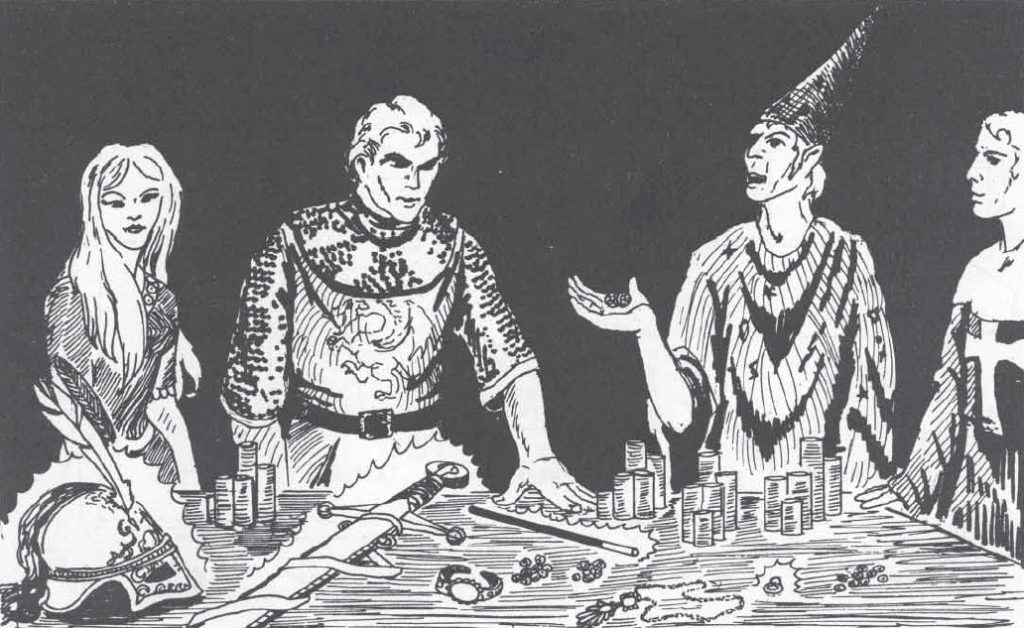
Step 2: Get Your Gear
Everyone starts with basic gear for adventuring. This includes a backpack, 50 feet of rope, 6 torches, 1 week of food rations, and a waterskin for water.
Then add gear based on your class.
Fighters get a sword that deals 1d8 damage, a shield to lower AC, and chainmail armor with AC 5.
Clerics get a mace (a blunt weapon), a shield, and chainmail. They can't use swords because of religious rules.
Magic-Users get a dagger for 1d4 damage, a spellbook with a few level 1 spells, and no armor or shield because they can't cast in armor.
Thieves get a short sword that does 1d6 damage, leather armor with AC 8, and thieves' tools to handle traps and locks.
AC 10 means no armor. Leather is AC 8. Chainmail is AC 5. Plate mail is AC 3.
Lower the AC number, the better.
Step 3: How to Play
Rolling Dice
Use a d20 to attack or save. Use a d6 to check things like surprise or opening doors. Use percent dice (d100) for thief skills.
How to Fight
Combat is a key part of the game. Here's how it works, step by step.
First, each side rolls a d6 for initiative. The side with the lowest number goes first. The DM might roll for each character individually instead, but usually it's one roll per side.
When it's your turn to attack, roll a d20. This is your "to-hit roll."
To figure out what number you need to hit, you compare your attack ability (based on your class and level) to the enemy's Armor Class (AC). In AD&D 1st Edition, lower AC means better armor.
Let's say your character is a level 1 Fighter. At level 1, most Fighters need to roll a 20 to hit AC 0. If the enemy has AC 7 (like leather armor), then you subtract 7 from 20. You need to roll a 13 or higher on the d20 to hit.
Your DM may use the official attack tables in the Player's Handbook or a shortcut called THAC0 (To Hit Armor Class 0), which simplifies this math.
If your attack roll is high enough to hit, roll the correct die for your weapon's damage. A sword might deal 1d8. Subtract that from the enemy's hit points. If the enemy drops to 0 HP, they die instantly. The same goes for your character.
How Attacks and Armor Class Work
In AD&D, your character has to roll dice to see if they hit a monster in battle. How hard it is to hit depends on your class (like Fighter or Thief), your level (how strong you are), and how much armor the enemy is wearing.
We use something called Armor Class (AC) to show how hard someone is to hit. A lower AC means better protection. AC 10 is easy to hit (like no armor), but AC 0 is really hard to hit (like heavy armor or a shield spell). Sometimes monsters even have negative AC, which is super tough!
To hit something, you roll a 20-sided die (called a d20). Your Dungeon Master (DM) looks at a chart to see what number you need to roll to hit the monster's AC. This chart is different depending on your class and level. Fighters get better at hitting faster than other classes.
For Spell Attacks
In Advanced Dungeons & Dragons, when you cast a spell like lightning bolt or fireball, you usually don't need to roll to see if it hits like you do with a sword or arrow. Spells follow different rules.
Most offensive spells don't care about a target's Armor Class. Instead, they ask the target to make a saving throw. A saving throw is like a last-chance defense. If the target makes their saving throw, they often take only half damage. If they fail, they take full damage. So when you throw a fireball into a room full of goblins, each goblin rolls to see if they dive out of the way fast enough to take only half the blast.
Spells usually happen at the end of a round, after weapons have swung. If the caster gets hit or distracted before the spell finishes, the spell might fizzle and be lost.
Some spells do work more like weapons. For example, if you're using a spell that needs to touch someone, like cause light wounds, then you do need to roll to hit. It works kind of like trying to punch someone. If you miss, the spell fails. Another example is spiritual hammer. It creates a magic weapon that swings by itself, but it uses your level to see if it hits, just like if you were swinging it yourself.
So, to keep it simple: most spells don't need a hit roll - they make the enemy roll to save - "saving throw". But if the spell is trying to touch someone or acts like a weapon, then yes, you may have to roll to hit.

Saving Throws
Sometimes bad things happen to your character, like being hit by a magical spell, stepping into poison gas, or getting caught in a dragon's fiery breath. When that happens, the DM will ask you to make a saving throw.
To make a saving throw, roll a d20. You are trying to roll equal to or higher than the number listed for your class and level on the saving throw table in the Player's Handbook.
There are five kinds of saving throws:
Poison or Death Ray: For deadly poisons or instant death traps.
Wands: For magical effects coming from magic wands.
Petrification or Polymorph: For spells or effects that try to turn you into stone or something else.
Breath Weapon: For huge area attacks like a dragon's breath.
Spells: For other kinds of magical spells.
Each class has its own saving throw numbers. At level 1, these numbers are high (around 13 to 17) because your character is inexperienced. As you level up, the saving throw numbers get lower, which means you get better at surviving danger.
If you roll high enough, you resist the effect. That could mean no damage, half damage, or avoiding a spell completely, depending on the situation. If you fail the save, the full effect happens.
Spells and Magic
Magic is powerful but limited. Clerics and Magic-Users cast spells, but they can only cast a small number each day.
Clerics start without spells at level 1. When they reach level 2, they gain the ability to cast one spell per day. Each morning, the cleric must pray to choose which spell or spells they will be able to use that day.
Magic-Users start with a spellbook that contains a few spells. At level 1, they can cast one spell per day. Each morning, the magic-user studies for an hour and memorizes one spell from their spellbook. Once they cast that spell, it disappears from memory until they rest and study again the next day.
Most spells only take one round to cast, but the effects can be very strong. Some spells affect enemies, some protect allies, and others can change the world around you.
For example, the spell Sleep can put a group of weak enemies to sleep instantly, with no saving throw. Magic Missile is another favorite; it always hits and deals a small amount of damage.
Spellcasters must stay safe in battle. If you take damage while casting a spell, you might lose it. And remember, Magic-Users cannot wear armor or they lose the ability to cast spells at all.
Choose your spells wisely. You won't get many at first, but they can turn a dangerous fight into a quick victory.
Spell Combat Basics
When a spellcaster wants to cast a spell in combat, the timing and conditions matter a lot. Here's how spell combat generally works in AD&D 1st Edition:
Declare Intentions First - Before initiative is rolled, players must tell the DM what their characters are doing. Spellcasters must say which spell they are trying to cast.
Initiative Is Rolled - Each side rolls a d6. The side with the lower roll acts first.
Casting Time Matters - Each spell has a casting time listed (usually in segments). There are 10 segments in a round. If something interrupts the caster before the spell finishes, it fails.
Being Hit Cancels Spells - If the caster takes damage from an enemy before their spell goes off, the spell is ruined. It is lost for the day and has no effect.
Spell Range and Targeting - The spell must reach the target based on its range. The caster must be able to see or otherwise target the enemy (some spells allow area effects).
Saving Throws and Effects - The target may get a saving throw if the spell allows it. If the save is successful, the spell might do nothing, or do half damage, or have a reduced effect depending on the spell description.
Armor and Spells - Magic-Users can't cast spells while wearing armor. Clerics can, because their magic comes from divine power, not study.
Example of Spell Cast Attack
A Magic-User tries to cast Sleep at the start of a round. The player declares it. Initiative is rolled: the monsters win and attack first. One hits the caster before the spell finishes. The spell is lost. No effect. If the Magic-User had acted first and wasn't hit, the Sleep spell would have gone off and possibly ended the fight before it even started.
How to Read a Spell Entry
Each spell in the Player's Handbook follows a set format. Understanding this format helps you know exactly how a spell works and what it can do in play. Here's what each part means:
Name and School: This tells you the name of the spell and the kind of magic it belongs to. For example, "Fireball (Evocation)" or "Cure Light Wounds (Necromantic)".
Level: This shows what level the spell is. Level 1 spells are for beginners; higher-level spells are stronger but harder to get.
Range: This tells how far away the spell can reach. Sometimes it's listed in inches (1 inch = 10 feet in dungeon scale). Other times it says "touch," which means you must be close enough to physically touch the target.
Duration: This tells how long the spell lasts. It could be in rounds, turns, minutes, or it might be "instantaneous," which means it happens and ends right away.
Area of Effect: This shows how much space or how many creatures the spell can affect. It might say "one creature," or it might say "20-foot radius," which means everyone in that circle is affected.
Components: These are what you need to cast the spell. There are three types:
V = Verbal (you must say words)
S = Somatic (you must make hand movements)
M = Material (you need physical items like herbs, gems, or holy symbols)
Casting Time: This tells how long the spell takes to cast, measured in segments (there are 10 segments in a round). Some spells take longer, like several full rounds or even turns.
Saving Throw: This tells whether a saving throw can resist the spell. It will say:
"Neg." if a successful save means the spell has no effect.
"%" if a save reduces the effect, often by half.
Or it might say "None," which means no save is allowed.
Description: This is where the spell's actual effect is described. It tells you what it does, how it works, any special rules or exceptions, and how the spell interacts with the game world.
Special Cleric Notes
Clerics use divine magic. They pray to their deity for spells, and some spells can be reversed. For example, "Cure Light Wounds" can become "Cause Light Wounds" for evil clerics.
Important points:
Clerics start without spells at level 1. Clerics must choose if they want a spell or its reverse before learning it. Evil clerics should avoid spells that promote good, and good clerics should avoid harmful spells unless allowed. Using spells that go against your alignment too often may cause your cleric to lose powers or change alignment. Religious items (like holy symbols) are not used up when casting, but special material components might be.
Your DM might change which material components are needed, or even skip them entirely. Always ask your DM how spellcasting is handled in their game.
Knowing how to read a spell entry will make casting magic smoother and help you make smart choices during play.
Understanding Types of Magic (Schools)
In the Player's Handbook, spells often list a type of magic (school of magic) in parentheses after the name. This is called the "school" of magic. It tells you what kind of magical power the spell uses. Think of it like the subject of the spell - what it's trying to do or how it works.
These magic types are mostly helpful for understanding how spells work and how different magic-users might specialize in certain styles of spellcasting. You don't need to pick a school when you create a character - AD&D 1st Edition doesn't make you choose one. All spells come labeled with their school automatically in the book. You just learn spells normally for your class and level. The school label helps explain how the spell works or how it might interact with magical defenses, magic items, or other spells.
Explanation of the Type of Schools of Magic
Enchantment/Charm spells mess with people's minds. They can make someone like you or follow your suggestions. Spells like Charm Person or Hypnotism use this school.
Conjuration/Summoning spells bring things into the world. That could mean calling up a monster, creating a magical effect, or even raising the dead. Examples are Bless or Animate Dead.
Alteration spells change things. They might make you bigger, turn someone invisible, or cause light to appear. Examples are Light and Enlarge.
Divination spells help you learn things. They might let you detect magic, find secret doors, or read minds. Detect Magic and ESP are examples.
Necromantic spells deal with life, death, and healing. Some heal the living, others control the undead. Cure Light Wounds and Animate Dead fall in this category.
Abjuration spells protect you or push away harmful magic. Spells like Protection From Evil or Dispel Magic come from this school.
Evocation spells make magic energy explode into the world. These are your direct-damage spells. Magic Missile and Fireball are perfect examples.
Illusion/Phantasm spells trick the senses. They make people see or hear things that aren't really there. Phantasmal Force or Ventriloquism are part of this school.
Sometimes, a spell is in more than one school. For example, Glyph of Warding is both Abjuration and Evocation because it protects an area and can explode when triggered.
Spell Progression
In AD&D 1st Edition, spellcasters learn more spells as they level up. The higher the level, the more spells they can use each day. Here's what you need to know:
Clerics
Clerics can start casting spells right at level 1. As they level up, they get access to stronger spells and more of them. Clerics pray to their gods for spells and usually don't use flashy magic. Their spells include healing, protection, and turning away undead monsters.
At first, they get one simple spell per day. By the time they reach higher levels, they can cast many spells each day from seven different spell levels. The stronger the spell, the higher spell level it is.
Druids
Druids are like nature clerics. They don't get spells until level 2, but after that, they work like clerics. They use spells related to nature, animals, and the weather. As they grow in levels, they get more and more spells each day, just like clerics, but their list of spells is a bit different.
Magic-Users
Magic-users are the classic spellcasters with pointy hats. They start with just one magic spell at level 1. As they go up in levels, they learn new spells and get to cast more of them each day. Their spells are powerful but often take time to prepare. Magic-users have access to spells all the way up to the 9th level, which includes some of the most powerful magic in the game.
Illusionists
Illusionists are a special kind of magic-user who focus on trickery and illusions. They start with one spell, just like magic-users, but their spell list is different. They specialize in spells that confuse or deceive enemies. They also eventually gain the ability to learn some basic magic-user spells.
What to Remember
Clerics and druids pray for their spells.
Magic-users and illusionists study and memorize their spells.
You get more spells as you level up.
The higher your level, the stronger your spells.
You don't have to memorize exact numbers. Just know that your spellcaster gets better as they level up, and your spell list grows with them. When in doubt, just check your class chart or ask your Dungeon Master!
Step 4: How to Explore
Careful dungeon movement is 120 feet per 10 minutes. Running is three times faster but might make you miss things.
Torches last one hour. Lanterns last four hours. No light means you can't see, and that's a big problem.
Most doors are stuck. Roll a d6. You open the door on a 1 or 2, or on a 1 through 3 if your character is strong.
Only thieves can detect traps with their skills, but in caverns and dungeons dwarves have their abilities to find traps involving pits, shifting walls, etc. Other players can describe what they do, like poking the floor with a 10-foot pole or tossing a rock ahead.
Step 5: Earning XP and Leveling Up
In AD&D, gaining experience and leveling up are how your character grows stronger, smarter, and more dangerous to dungeon-dwelling creatures everywhere.
Characters start at 1st level with zero experience points. They earn XP through several methods, mostly by surviving dangerous situations and dragging back gold. Seriously. One gold piece equals one experience point. Slay a monster, find a chest full of coins, come home alive, and boom - XP.
The DM gives out experience after an adventure, usually once the group returns to town. XP comes from treasure (converted to gold value), defeating monsters (based on their hit dice, powers, and danger), and handling situations using class-appropriate skills. Killing stuff gets points, sure, but solving problems the clever way also counts.
If you sell magic items right away, you get XP equal to their gold value. If you keep them, the XP reward is minor, because the real benefit is, well, using magic. Also, if you crush weaklings (say, a 5th-level fighter slapping a lone kobold), the XP reward for treasure might get cut way down - overkill doesn't impress the gods of advancement.
Monsters give full XP when captured or slain. Big monsters with lots of health, special powers like fire breath or gaze attacks, or strong magical abilities, all give bigger XP prizes. Capturing and selling monsters (if that's your thing) earns XP too, based on the gold you make.
High stats can boost XP gains. Fighters with Strength 16+, Magic-Users with Intelligence 16+, Clerics with Wisdom 16+, and Thieves with Dexterity 16+ get 10% more XP. Some special classes have stricter requirements - Rangers need Str, Int, and Wis all over 15, and Paladins need a whopping 17 Charisma. Monks, poor souls, never get a bonus.
Henchmen only earn half the XP they'd normally get, and sometimes even less. They're your backup crew, not the stars of the show.
Leveling up means gaining power. Each class has a different XP chart, so some level up faster than others. When you level, you roll another hit die to increase hit points. Constitution helps - a good bonus can mean the difference between getting smacked around or walking it off. Multi-classed characters roll for each class, add it up, divide by the number of classes, and round up.
Most people in the world are 0-level nobodies. They don't get XP or levels. Player characters are the rare heroes destined for greatness (or hilarious failure). And yes, the DM controls how XP is handed out. Try not to argue. They hold the XP keys.
More About XP
When the group slays or captures a creature, the XP it grants is calculated based on its hit dice, hit points, and any special abilities like spells, breath weapons, or regeneration. This total XP is then divided among the party members.
The exact method of sharing isn't spelled out in stone, but it's generally understood that everyone who contributed to the fight gets a share, not just the hero who landed the killing blow. The Dungeon Master (DM) handles the math and ensures the distribution is fair. If you were part of the action and helped the party succeed, you'll likely get a cut of the XP pie.
For characters with more than one class (like an elven fighter/magic-user), the XP they earn is split evenly between their classes. So, a 1,000 XP award turns into 500 XP for fighter and 500 XP for magic-user.
Ultimately, XP is a group reward. It gets pooled, split, and handed out under the DM's watchful eye. If the party worked together to take down the monster, they grow together from the experience.
What You Need to Start Tonight
The DM needs a simple dungeon map with 5 to 10 rooms, some monsters and treasure from the rulebooks, and dice.
Players need paper and pencils for their characters, a set of dice, and a good imagination.
Start the game like this:
You stand in front of a dark cave. The villagers say goblins live inside. They'll pay you 50 gold per goblin ear. What do you do?
Let the players talk. Ask what they want to do. Roll dice when it makes sense. Keep things moving and have fun.
Final Tip
If you're not sure about a rule, just make a call and move on. The real fun comes from exploring and problem-solving together. You'll learn the rest as you play.
You're ready. Grab your dice. Adventure awaits!
Player's Handbook Errata for AD&D 1st Edition 1980
Players Handbook Errata first published in The Dragon Magazine #36 (Vol. IV, No 9, March 1980)
Wisdom should be changed to read as follows, "Furthermore, clerics
with exceptional wisdom (13 or greater) also gain bonus spells over and
above the number they are normally able to use."
Wisdom Table II should be changed to read "Adjustments for Clerics
and Druids."
Dexterity Table I: Strike from ability score 14 "Maximum dexterity for a
half-orc character." Ability score 17 should read, "Maximum dexterity for
a dwarf or half-orc character."
Character Race Table III: The dexterity scores for half-arcs should read
"3/3; 17/17."
The Magic-user, fifth paragraph, first sentence should be changed to
read, "When a magic-user attains 7th level (Enchanter) or higher, he or
she may scribe magic scrolls and concoct potions, and upon achieving 12th
level (Wizard) or higher may attempt to enchant items."
The Thief, additional abilities #2 should read, "At 4th level (Robber)
thieves are able to read 20% of languages, and this ability increases by 5%
with each additional level of experience until an 80% probability is attained."
The Monk, paragraph 5 should be changed to read, "With respect to
combat, monks attack on the same table as clerics."
Weapon Types Table: The entries for military pick should read, "Pick,
Military, Footman's; Pick, Military, Horseman's."
Hurled Weapons and Missiles: The last sentence should be changed to
say, "Adjust by - 2 at all medium ranges, -5 at all long ranges."
The level of Detect Lie should say, "Level: 4."
Cure Critical Wounds: The following sentence should say, "Its reverse,
cause critical wounds, operates in the same fashion as other cause wounds
spells, requiring a successful touch to inflict the 6-27 hit points
Water Breathing: The components should say "Components: V, S."
Explosive Runes: Saving throw should be altered to say, "Saving Throw:
None or ½."
Addition 87A
Delayed Blast Fire Ball: Add to the components so it reads,
"Components: V, S, M."
The Outer Planes: Number 21 should read, "The furnaces of Gehenna
of evil lawful neutrals."
NEW COPY -
CHARACTER RACE TABLE Ill: ABILITY SCORE MINIMUMS
AND MAXIMUMS
The limitations given for races on the Ability Score Table are intended to
apply to the entire race, not lust player characters. Therefore, several inconsistencies
between the maximum scores and the player character
racial adjustments are not mistakes. For example, although player
character elves have a -1 on their constitution, the racial maximum for
constitution of elves is 18. This is because, as explained in the Dungeon
Master's Guide, exceptional non-player elves may have a constitution of 18l. Likewise, although it is impossible for a player character halfling to roll the maximum 19 constitution, a non-player halfling could,
